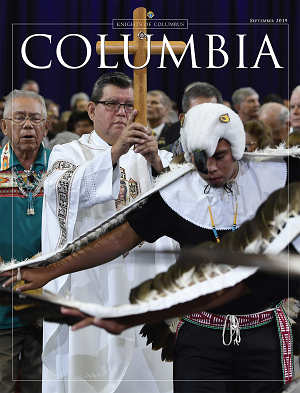
A Message of Hope
Father Maurice Sands spoke with Columbia about his personal background and about the broader experience of Native Americans within the Catholic Church.
Read the Interview with Father Sands about the experience and needs of Native American Catholics today HERE
Mission
The Bureau of Catholic Indian Missions is a Catholic charity that was established in Washington, D.C. in 1874 to advocate for the needs of Catholic Native Americans. Supporting building projects, staffing schools, enabling parish religious education programs, raising awareness of the needs of Native American and Alaska Native Catholics, and calling others to share this mission has been at the heart of the Bureau’s work since its founding.
History
The first Commissioner for the Catholic Indian Missions—in 1873—was a layman and Army veteran of the Civil War, General Charles Ewing.
The Bureau of Catholic Indian Missions has a rich and storied past, along with a promising future. The Bureau has lived out its Mission to the Missions since 1874, when it was founded as the office of the Commissioner for Catholic Indian Missions.
Recognizing the importance of preserving the records of its rich history, the Bureau partnered with Marquette University’s Special Collections and University Archives in 1977 to make it the Bureau’s official repository.* The partnership continues to the present day, with Mr. Mark G. Thiel, C.A., serving as the Archivist.
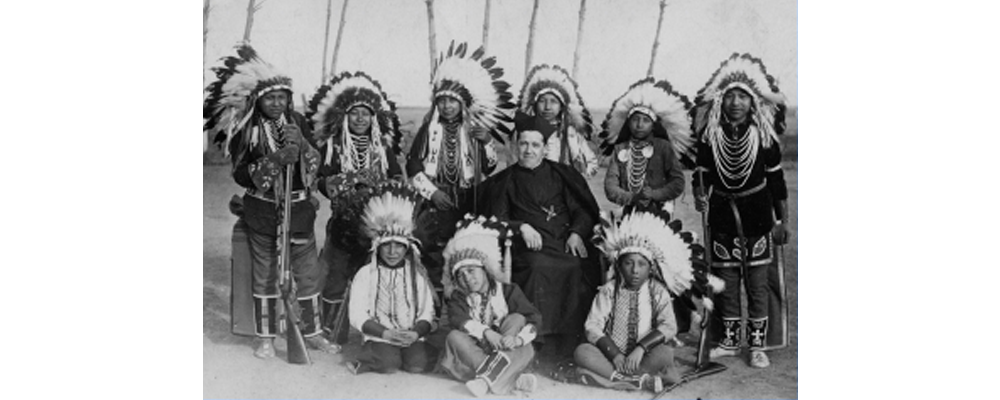
A Voice for Catholic Indians:
The Birth of The Bureau of Catholic Indian Missions
One in a series of historical reflections by Tim Lanigan
At a moment when the vice president of the United States, the speaker of the House of Representatives, and six of the nine justices of the Supreme Court are Catholic, it may be hard to imagine a time when Catholics were not only a small percentage of the population, but a marginalized one as well. For example, in the 1850s, only five percent of Americans were Catholic. Today, it’s 25 percent. But more importantly, in the late 19th Century, Catholics had little representation in the seats of power.
It was just this lack of an effective voice in the nation’s capital that led to the creation of one of the oldest, most long-lasting Catholic institutions in the United States. This year marks the 140th anniversary of the Bureau of Catholic Indian Missions. It was created during a moment of what Philip Weeks, a scholar of American Indian history, has called a period of “intense anti-Catholic sentiment” in the nation.

Hundreds of Catholic missionaries had been sharing their lives and religion with American Indians since Franciscan friars arrived in New Mexico in 1540. By 1630, 25 mission residences served some 35,000 Christian Indians in New Mexico’s 90 churches. Among the better known missionaries in North America was St. Isaac Jogues, who ministered to Indians in 17th Century New France. Another well-known missionary was Fr. Peter DeSmet, who spent 50 years among Native Americans in the mid-West and West It was a French priest, Fr. Jacques de Lamberville, who in 1675, studied the catechism with an 18-year old Mohawk woman and helped lead her along the road to becoming one of America’s most famous saints – Saint Kateri Tekakwitha.
The collision of two cultures, one of the European immigrants, the other of Native Americans, didn’t go smoothly. Almost 400 years after Columbus landed in Hispaniola, and more than 250 years after the English landed in Virginia, settlers in the United States and Native Americans were still struggling with each other over many issues, especially over land. Despite many treaties with Indian tribes, American settlers seized Indian lands, first crossing over the Appalachians and then moving across the Mississippi River. Treaties were signed, then disregarded. By one estimate, Americans broke 370 treaties on their way West.
American missionaries, many of them Catholic, shared their lives and religion with tribes throughout the United States. While the popular culture of Americans fed on wild tales of Indian savagery, those who knew them best, the missionaries, came to respect their cultures and common decency. Fr. DeSmet, for example, once cited a New Mexico court decision that declared that “vastly less” crime would be found among a thousand of the worst of the Pueblo Indians than among an equal number “of the best Mexican or Americans in New Mexico.” He went on to note that every Pueblo village had erected a Catholic church, each with its own priest, and that the Pueblos were a “peaceable, industrious, intelligent, honest and virtuous people.”
It was this close relationship with Native Americans that called into question a decision by the federal government in 1870 to test a new government policy in its dealings with Indian tribes. In 1870, President Ulysses S. Grant was fed up with the corruption and public scandals within the government agencies handling Indian affairs. In what became known as “Grant’s Peace Policy,” Grant decided to hand over jurisdiction of the tribal lands to Christian missionaries, people who knew the Indians well and were more likely to put the interests of the Native Americans above their own interests.
What stunned Catholic missionaries was the way the jurisdictions were handed out. President Grant decided to create a Board of Indian Commissioners, which would advise the Bureau of Indian Affairs. This Board was designed to represent all Christian denominations. Yet it soon became apparent that all of its ten members would be Protestant. And it was also apparent that all of the Indian agencies would be subject to the Board’s rule.
The resulting distribution of agencies went as might be expected from the makeup of the Board. As told by Philip Weeks in Farewell, My Nation, a standard history of the American Indian used on many college campuses, the Catholic Church “had been more active in the Indian mission field than any other denomination. The Roman Catholic Church also had contributed more than half of the funds for missions on the reservations.” Grant’s guidelines, he added, “recommended that an agency should be assigned to the missionary sect that already worked there among the Indians.” While churches other than Catholic claimed only 15,000 Indians, the Catholic Church knew it had 106,000. The Church expected to be given 38 agencies. Yet, of the 94 initial agency appointments, the Catholic Church was awarded only seven.
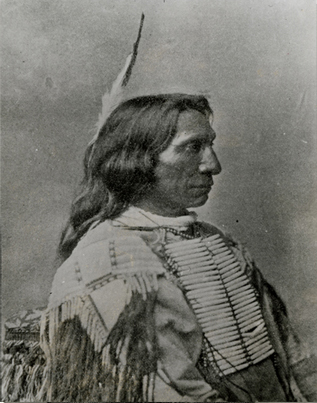
As a result of this unfair distribution, some 80,000 Indians, devout Catholics, were handed over to other denominations. In a number of instances, where Protestants attempted to establish parishes, Catholic Indians refused their ministry and said they were waiting for “Black Robes,” their term for Catholic priests. Catholic priests were forbidden to enter certain reservations to preach or minister to the Indians, and the Catholic Indians themselves were forbidden to attend Catholic worship even off the reservation. In one case, Chief Red Cloud of South Dakota’s Pine Ridge Reservation wanted Black Robe missionaries on his reservation and invited one to visit. But the resident agent had the Benedictine priest escorted off the reservation at gunpoint.
It soon became apparent that one of the advantages of relying on Catholic clergy was their willingness to work in a difficult environment without substantial financial compensation, an advantage not shared by members of many other denominations. As explained by Henrietta Stockel, a former executive director of the Albuquerque Indian Center and the author of many books on Native Americans: “Problems quickly appeared. The small salary was insufficient for many agents, and in some cases rapid turnover resulted. Married men brought their wives, many of whom, despite good intentions, learned they could not tolerate the seclusion and demanded a return to ‘civilization.’
The Catholic hierarchy in the East had been urged years before to set up an office for Indian affairs in the nation’s capital. It was the unfair administration of the new Grant Peace Policy that gave the request special urgency. The spiritual interests and well-being of Catholics, both Native Americans and missionaries, thousands of miles to the west, depended in large measure on having a voice in Washington.
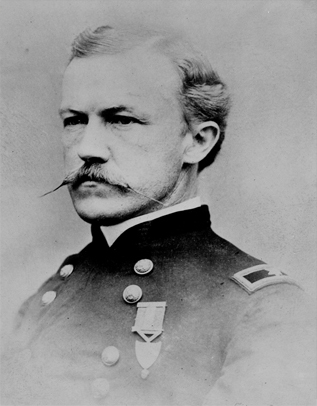
The result was the creation of the Bureau of Catholic Indian Missions. It brought together two people who would do more than anyone else to get this organization up and running: one, a layman, General Charles Ewing; the other, a priest and missionary, Father John Baptist A. Brouillet.
General Ewing, a veteran of the Union Army during the Civil War, was a lawyer and an influential presence in the city of Washington. His father was a senator and a cabinet secretary; both brothers were generals in the Union Army. General Ewing served with distinction in the Army of the West. He was wounded three times in the Siege of Vicksburg, but remained in the Army, rising to the rank of brigadier general. Above all, he was a man of action. In January, 1874, he was appointed the first Catholic Indian Commissioner in the United States and Western Territories by Archbishop J. Roosevelt Bayley of Baltimore.
But Ewing lacked firsthand knowledge of the needs of American Indians. That close knowledge is what Father added to the Bureau. He had been a missionary with vast experience among the Native Americans of the Northwest. Originally a professor of literature and parish priest in French Canada, he happened to meet Augustin Blanchet, the recently appointed Bishop of Walla Walla in the American Northwest. Bishop Blanchet was encouraging priests to take up work in the missions. He was impressed by the young Father Brouillet and asked him if he would consider giving up his parish to become a missionary. Brouillet responded: “Here I am.”
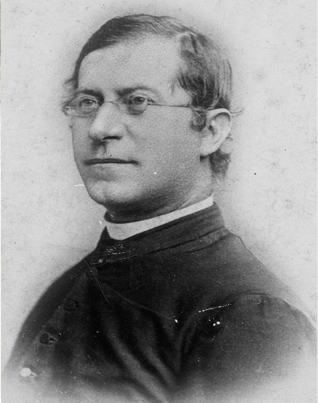
The two set out for Walla Walla in early 1847, a trip that took six months. As vicar general, Father Brouillet quickly helped organize the new diocese. He recruited Jesuit priests to minister to the growing population of Catholic Indians and Sisters of Notre Dame de Namur to teach in the schools. The discovery of gold enriched many in California, and Bishop Blanchet sent Father Brouillet to San Francisco to raise funds for the desperately poor Walla Walla diocese.
In 1859, fearful that homesteaders and others might challenge the ownership of mission lands, Bishop Blanchet sent Father Brouillet East on the first of several trips to Washington to protect mission property by securing clear titles, as well as to raise funds and find missionary recruits.
All of this experience made Father Brouillet the ideal candidate when, in 1874, General Ewing was looking for someone to be the first Director of the Bureau of Catholic Indian Missions.
The two men faced sizable challenges. As recounted by Kevin Abing of Marquette University, one was the need for finances to support the Bureau offices, as well as the many Indian missions. Their most successful source of funds was the Ladies’ Catholic Indian Missionary Association, a group created by the
Bureau to raise money. A second challenge was to secure papal approval. The existence of the Bureau was not uniformly popular within the American church. In 1879, Father Brouillet traveled to Rome to obtain the blessing of Pope Leo XIII. Six months after he arrived, he obtained a formal approval from a Vatican congregation, establishing the Bureau on a firmer foundation within the American church.
A third challenge was creating more Catholic schools in the missions. In 1873, there were only three Catholic boarding schools. Ten years later, there were eighteen. By 1890, there were 43 boarding and 17 day schools, with the federal government paying almost $400,000 a year for financing the schools. This remarkable success had unfortunate results. Other denominations, jealous of Catholic successes in this area, began to lobby for an end to the funding for all Indian schools, with the result that Congress voted in 1896 to end funding for “education in any sectarian school.” These schools then became more reliant on funding from the Bureau.
The fourth challenge was the spark that created the Bureau from the start: seeking a more equitable distribution of Catholic missions among the Indians. Here, the results were mixed. President Grant’s Peace Policy was eventually scrapped. Christian missionaries no longer played such a central role in selecting those who administered the agencies. And it wasn’t until 1902 that Catholics were appointed to the Board of Indian Commissioners, the breakthrough coming during the administration of President Theodore Roosevelt.
Perhaps it is a testimony to their hard work in those initial years that both General Ewing and Father Brouillet died within ten years of their appointments. But their legacy was putting the organization on a solid footing, an organization that 140 years later continues to support the rights and needs of Catholics among America’s Indian tribes. Today the Bureau of Catholic Indian Missions is still hard at work bringing spiritual, educational, and financial support to the important mission of spreading the word of God and improving the quality of life of America’s native peoples.
Monsignor Stephan and the Indian Schools
Second in a series of historical reflections by Tim Lanigan
The late 19th Century was a time of testing for the newly established Bureau of Catholic Indian Missions. The two principal founders of the Bureau died within a year of each other. Brigadier General Charles Ewing, the Bureau’s founding commissioner, died in mid-1883; Father John Brouillet, the first director, in early 1884. Both men, as recounted in the Spring 2014 issue of the Sentinel, had worked hard, over a period of ten years, to put the Bureau on a solid footing.
The two men sought and received a more formal recognition of the Bureau from the Vatican; they raised funds to support the Bureau’s offices and its missions; and they helped create many more schools in the missions. It was this last effort that created the biggest challenge in the following 17 years. At the time the Bureau was founded, there were only three Catholic boarding schools for Indians. Ten years later, there were eighteen. By 1890, there were 43 boarding and 17 day schools, with the federal government paying almost $400,000 to support the schools.
This remarkable success was a mixed blessing. It gave many more Indian youngsters the opportunity to learn what they needed to know to prosper in a changing world and introduced them to the fundamentals of Catholic Christianity. But at the same time, this very successful program aroused the envy of other Christian denominations and led to a fight that pitted the Bureau’s new director against the new director of the federal government office that administered Indian Affairs.
On one side was Msgr. Joseph A. Stephan, who served as director of the Bureau of Catholic Indian Missions from 1884 to 1901. On the other was Thomas Morgan, the federal government’s Commissioner of Indian Affairs, brigadier general in the Civil War, an educator, and a Baptist minister.
The Fighting Priest
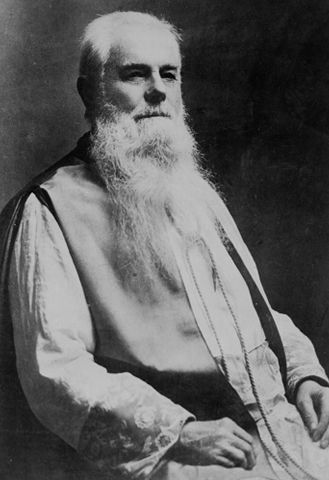
Msgr. Stephan came to this assignment through an unusual route. Born in 1822 in the Grand Duchy of Baden, in the south-western region of present-day Germany, he had worked as a carpenter and later as a military officer, before studying civil engineering and later philology at two schools in Germany.
While studying philology, he was struck blind for unknown reasons. According to Kevin Abing of Marquette University, “Stephan turned to God in this trial. He reportedly pledged to become a priest if his eyesight returned,” which it did two years later. He made good on his vow, but in 1847, while studying scholastic philosophy in preparation for the priesthood, Stephan learned that his father, who had emigrated to the United States, was dying. Leaving for the U.S. in 1847, Stephan arrived in time to visit his father one last time before he died.
Stephan remained in the States, deciding to pursue his theological studies in a seminary of the Diocese of Cincinnati. He was ordained in 1850 and served parishes first in Ohio and later in Indiana. Both states were on America’s frontier at the time, which called for people who could apply a wide range of skills in building up the new regions. Msgr. Stephan was well prepared. As told by Abing, he was well-educated, a trained engineer, a musician, and a cook. He was an inspirational speaker, a bundle of energy, and a strong administrator, which were necessary skills in building, and in some cases, rebuilding, parishes.
Commissioned a chaplain during the Civil War, he not only ministered to the troops but also helped design and build a pontoon bridge, an achievement that so impressed his superior officers that they urged him to make a career in the military.
He turned the offer down and eventually became committed to the cause to which he would devote the rest of his life, the well-being of the American Indian. In 1878, while serving within the Diocese of Fort Wayne, Indiana, he applied for a position as the government’s agent in the Standing Rock reservation in the Dakotas.
Msgr. Stephan found the job of agent a tough assignment. He complained of dealing with the missionaries who worked at the schools and the soldiers who manned the garrison at Fort Yates. He found the Indians to his liking, “a peaceable, industrious, and good” group, as he called them. The whites he accused of “harassing, backbiting, and lying,” adding he was disgusted with the place. So it was no surprise that Stephan, an impatient man with the temperament of a fighter, resigned from the assignment in 1881, three short years after accepting it.
But that certainly did not end his relationship with Indian affairs. In 1884, after serving for three years in parishes in the Dakotas, Msgr. Stephan was chosen to head the Bureau of Catholic Indian Missions, replacing Father Brouillet.
The Conflict that Awaited Him
If Msgr. Stephan thought he had had a difficult relationship with missionaries and soldiers at Standing Rock, he would soon find that that assignment was sweet harmony compared to what he would find at the Bureau’s headquarters in Washington. What awaited him was one of the most divisive issues in the nation, the government’s funding of religiously administered contract schools for American Indians.
In the 1870s and 1880s, Congress simply wasn’t willing to appropriate large sums of money for the government-run schools for Indians. Even by 1887, for example, these schools were educating only 10,000 students out of an Indian population of 300,000. And the teaching and administrative positions at the schools were often handed out on the basis of political patronage, a situation too open to incompetence and corruption.
In the mid-1870s, the government found a way to circumvent these problems. It funded the schools, but left the staffing and administration of them to religious and charitable groups, institutions more likely to spend the money wisely and honestly. These schools not only offered academic training, but religious instruction and example as well.
But it was the success of the Catholic-run schools that led to the program’s demise. By 1890, almost two-thirds of the government funding went to Catholic-run schools, a situation that dismayed the largely Protestant national leadership of the time.
The success of the Catholic schools played into the hands of American nativists, who had once recoiled at the sight of boatloads of Irish Catholics arriving in New York harbor and Boston harbor in the 1840s and 1850s. If the nativists were upset during this period, they were shocked by what followed after the Civil War.
The Issue Behind the Conflict
Between 1880 and 1921, almost 24 million immigrants arrived in America. This was an enormous increase to the 1880 population of 50 million. But it wasn’t the size of the population shift alone that stirred emotional debates. Where many immigrants in the early 19th Century had come from such northern and western European countries as Ireland and Germany, this second wave of immigration was largely from such southern and eastern European countries as Italy, Poland, and Russia. Catholics made up a large percentage of this new wave of immigration. In 1850 Catholics made up only five percent of the total U.S. population. By the first decade of the 1900s, their numbers had arisen to 14 million, or 17 percent of the total population. By then, Catholics were the largest single religious denomination in the country. Those politicians and educators and writers who had long seen America as white, Anglo-Saxon, and Protestant were stunned by the abrupt change in the culture, and they fought back.
The arrival of immigrants from the non-English speaking, largely Catholic parts of Europe gave rise to such groups as the American Protective Association, an anti-Catholic society created by Protestant groups in 1887. Among the Association’s policy objectives was the complete separation of Church and State. That goal included the promotion of a non-sectarian public school system and a prohibition of any government funding of religious groups, an outcome, if enacted in public law, would have a profound effect on the education of American Indians.
The case of many of those who opposed the Catholic schools was simple: Indians should be educated in public schools. Their argument might have been summed up like this: The more people are like each other, the more peaceful society will be. America has had an identity, one that is white, Anglo-Saxon, and Protestant. That identity should be passed on to future generations, whether descendants of early settlers, new immigrants, or American Indians. Education, many thought, was the best way to hand down a common culture. In fact, early advocates of public education often referred to public schools as “common schools.” Of course, back then it was assumed that a real education would be permeated with Christianity. The question was: whose version?
To virtually all of the people who made public policy in those days, the answer was simple: the Christianity that the Pilgrims and Puritans and Anglicans brought from England in the early 17th Century. This identity was passed on to generations in the 19th Century through McGuffey Readers, the most widely used textbooks ever created in America. These readers brought students the basic skills of reading through stories, poems, and essays that offered moral and spiritual uplift, and that not so incidentally created an impression of a white, Anglo-Saxon, Protestant as the model American. The world views of virtually all of the late 19th Century public figures Msgr. Stephan worked with were no doubt informed by these texts and others like them.
The Fighter in the Other Corner
Among the Protestant leaders was Thomas Jefferson Morgan. Morgan was certainly Msgr. Stephan’s most combative and determined foe. Msgr. Stephan represented Catholic Indian schools during five presidential administrations, but it was during the presidency of Benjamin Harrison, from 1889 to 1893, that the debate was most heated. It was also during this administration that the general outlines of a final resolution to the issue of government funding were resolved.
Harrison had been Morgan’s old commander in the Civil War. After the war he went on to become a lawyer, a Presbyterian elder, and a U.S. Senator. In 1888, Harrison, a Republican, was elected president. He shared a similar philosophy with Morgan and when it came time to appoint a new commissioner of Indian Affairs, Harrison chose his former Civil War subordinate.
The choice of Morgan was bound to be divisive. He was profoundly anti-Catholic, a zealous member of an anti-Catholic organization, the League for the Protection of American Institutions, and was in his later years an outspoken member of the nativist American Protective Association.
But Morgan’s animus toward the contract schools was not simply a matter of anti-Catholicism. His advocacy of public education also shaped his views about schools run by the Catholic Church. His background as a Baptist minister and an educator convinced him that the best way to pass on the “civic culture” was through public education. The civic culture he had in mind was a largely Protestant culture, as typified by the historical textbooks of the time, which stressed the stories of the Puritan and Anglican founders of the nation. The easy equation of public education and the Protestant religion “was part of the spirit of the age,” as Father Francis Paul Prucha, S.J., put it in his comprehensive history of the issue, The Churches and the Indian Schools, 1888-1912.
The Battle Begins
Msgr. Stephan felt he had no choice but to lead the challenge to the nominations of Morgan and especially the man Morgan chose as Superintendent of Indian Schools, the Reverend Daniel Dorchester. Dorchester was a Methodist clergyman and a virulent anti-Catholic, who just prior to his nomination wrote that the Catholic Church was plotting to destroy American institutions.
Msgr. Stephan fought tirelessly against the nominations of Morgan and Dorchester, but to no avail. Both were confirmed by the Senate after a long, drawn out struggle led by Stephan, who was supported by such Church luminaries as James Cardinal Gibbons, Archbishop of Baltimore and the senior American prelate, as well as two other archbishops, John Ireland of St. Paul, Minnesota, and Patrick W. Riordan of San Francisco. Stephan had cultivated many friends and allies in Congress as well. But the momentum behind the unstoppable trend toward public education and the negative public reaction to the arrival of so many recent immigrants helped push the two nominations through the Senate.
It was clear from Morgan’s advocacy of public education and from his general dislike of the Catholic Church that he was determined to defund the Catholic Indian contract schools. His arguments still resonate in battles over the proper relationship between Church and State today.
Morgan and his allies charged that the government-supported schools violated the principle of the separation of Church and State. They argued that the Catholic religion was alien to America’s long-standing principles and ideals, especially the principle of popular democracy. This charge they supported by accusing the American Church of reporting to a foreign power, namely, the Pope. One Morgan ally, the Reverend James M. King, described America’s identity this way: “Our civilization is not Latin, because God did not permit North America to be settled and controlled by that civilization.”
Msgr. Stephan and his allies responded by pointing out that Catholics staffed the Indian contract schools because of a government invitation to do just that, largely because of its inability to staff all of them itself. He pointed out all the good work that the Church had done in the schools and that the government didn’t have the resources to replace the schools, arguments that opponents of the contract schools readily conceded. Archbishop John Baptist Salpointe of Santa Fe, New Mexico, pointed out that the schools in many cases had been developed after long years of hard work and that to destroy these institutions was unfair. He added, pointedly, that if given the choice between government and Catholic schools, the Indians in his archdiocese would most certainly choose the Catholic schools.
The End in Sight
At the urging of some of his allies, Morgan softened his position somewhat, but not enough to make a difference in the long-run funding of the schools. In the face of numerous attacks on his proposal, and even his character, Morgan pointed out that he had actually increased funds to contract schools, that he wouldn’t close them suddenly, but that he had no intention of backing down on his overall plan of replacing such schools with government-run institutions. The issue came to a head in 1891 when the Protestant churches agreed to reject government funding for their Indian schools as a way of pressuring the Catholics to do the same. Of course, they were confident that government-run schools would emphasize the same Protestant values that such schools had since the beginning of the public school system.
The contract schools question became a heated issue during the 1892 presidential campaign. Harrison lost to the man he had replaced in 1889, Grover Cleveland, a Democrat, and someone who was more likely than the Republican Harrison to curry favor with Catholic voters. Both Morgan and Dorchester were replaced by Cleveland, but the Democratic victory couldn’t reverse the trend to public education. That became more clear when Cleveland appointed Daniel Browning as Commissioner of Indian Affairs rather than reappoint the commissioner who served in Cleveland’s first administration and who was the favorite of the Catholic hierarchy.
Msgr. Stephan continued the fight over the 1890s, relying primarily on his allies in Congress. But Congress gradually defunded the contract school program over the succeeding years, until it finally stopped all aid in 1900. That year, William A. Jones, Commissioner of Indian Affairs in the William McKinley administration, wrote to Stephan, inquiring which schools he intended to close so that Jones could transfer their students to the government schools. Stephan’s reply: none of them. He was determined that none of his more than 2,000 students should be deprived of a Catholic education, even though it would cost the Bureau about $150,000 a year. It was a bold decision, very characteristic of the immigrant priest who devoted his life to serving the well-being of Native Americans.
But Msgr. Stephan’s years in Washington had sapped his energies. In 1900, he had traveled to Europe to regain his health. After returning to the United States, he was attending a convention in Washington, and died very suddenly in September of 1901.
When he passed away, he was no doubt confident that his work with the American Indian schools had not been in vain. And with good reason. Over the years, he had developed a friendship with one of America’s great saints, a woman who helped see to it that the Bureau of Catholic Indian Missions would continue its work with America’s original inhabitants. But that story can await the arrival of the man who would replace Msgr. Stephan: Monsignor William H. Ketcham.
Historical Resources
Marquette links - People – Events – Missions/Parishes
eArchives - Marquette’s online repository of digital records
Father Raymond Bucko, S.J., Ph.D. - Jesuit anthropologist specializing in American Indian studies
Christopher Vecsey, Ph.D. - Chris’ scholarly work in American Indian studies also includes a great deal of material on Catholic Native American missionary activity.
* Records from 1874-1980 are also held on microfilm at the American Catholic History Research Center and University Archives of The Catholic University of America.
Publications - Sentinel and Dream Catcher
School & Parish Grants
Marquette University eArchives
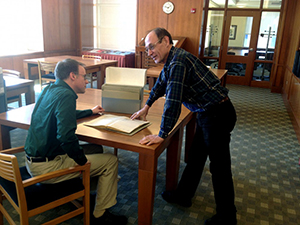
Mark G. Thiel, C.A. (Certified Archivist), Marquette University who manages the Black and Indian Mission Office records at work in the John P. Raynor, S.J., Library assisting researchers.
Archival material can be found at the Marquette University e-Archives
Marquette’s identity as a Jesuit institution makes it uniquely suited to collect “records of organizations which document Catholic activity among Native Americans in the United States, and records and papers relating to Christianity in rural and urban Native American communities” (Collecting Policy). Members of the Society of Jesus have worked among Native Americans and Alaska Natives since the 1500s.
Partners
The Bureau of Catholic Indian Missions actively partners with a number of vital organizations around the country who share the desire to spread the Gospel in Native American and Alaska Native communities. No successful organization ever operates in isolation! See the good things that our friends are doing.
- USCCB Secretariat for Cultural Diversity in the Church
- The Tekakwitha Conference organization, founded at Fargo in 1939, seeks to empower Catholic indigenous people as leaders within their communities. The annual Tekakwitha Conference gathering has been held each summer in every corner of the United States.
- Sioux Spiritual Center in the Diocese of Rapid City serves as a center for ministry formation and prayer for Native American Catholics among the numerous Indian tribes in western South Dakota. The BCIM has been a longtime supporter of the Sioux Spiritual Center.
- Kateri Northwest Ministry Institute, located in Spokane, empowers Native American Catholics in the Pacific Northwest to serve their People and affirm their cultural and spiritual identity. KNMI encourages the People to take responsibility for the religious life of their local community.
- Diocesan Native American Ministry offices





